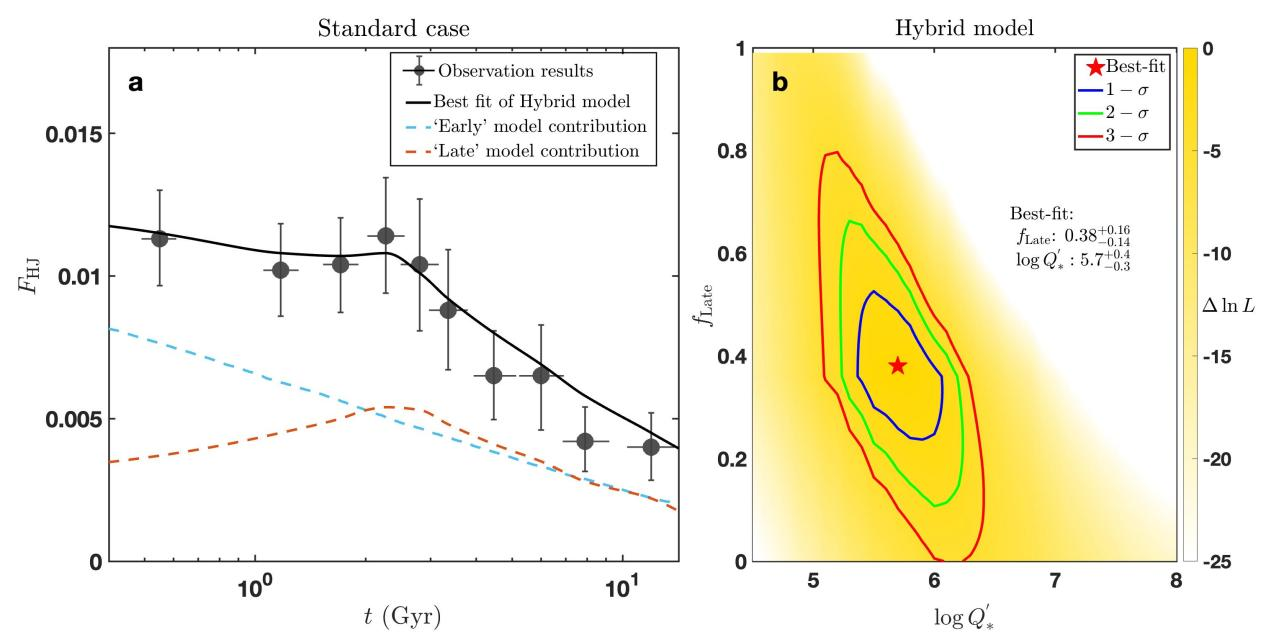You are here
Hot Jupiter Origin Unveiled! LAMOST Helps Reveal Formation Mechanisms and Tidal Evolution Pathways

Figure 1: Schematic diagram of two populations of Hot Jupiters with different orbital configurations and different formation mechanisms.
A new study published in the prestigious journal Nature Astronomy on October 31, 2025, has uncovered a segmented decline in the occurrence rate of hot Jupiters with stellar age, providing the first clear evidence that these giant exoplanets form through multiple distinct mechanisms operating over vastly different timescales. The research, led by an international team using data from China's LAMOST and Europe's Gaia telescopes, also delivers precise constraints on stellar tidal dissipation, resolving long-standing questions about the orbital evolution of close-in planets.
The paper, titled "The origin and tidal evolution of hot Jupiters constrained by a broken age–frequency relation", reveals that approximately 60% of hot Jupiters migrate to their close-in orbits within tens of millions of years, while the remaining 40% arrive over much longer timescales extending to billions of years through a long-term chaotic (so called “secular chaos”) migration process.
Challenging Planetary Formation Paradigms
Hot Jupiters – gas giants orbiting perilously close to their host stars – have puzzled astronomers since their discovery in 1995. The first known exoplanet, 51 Pegasi b, defied classical formation theories that predicted giant planets should form only in the cold outer regions of planetary systems.
"These planets shouldn't exist so close to their stars according to our Solar System-based models," said corresponding author Professor Ji-Wei Xie from Nanjing University. "For three decades, we've debated how they reach such extreme orbits. Now we have quantitative evidence that multiple pathways are at work."
Two Populations, Two Formation Mechanisms
The research team analyzed a substantial sample of hot Jupiters orbiting Sun-like stars, finding that their occurrence rate doesn't decline uniformly with stellar age. Instead, it shows a distinct breakpoint at approximately 2 billion years.
"This broken pattern indicates two separate populations," explained first author Dr. Dichang Chen, who graduated from Nanjing University and recently joined Sun Yat-sen University as an associate professor. "The 'early-arrival' population reaches final orbits quickly, within tens of millions of years, likely through disk migration or early dynamical interactions. The 'late-arrival' population takes much longer – up to billions of years – suggesting a different mechanism."
The late-arriving hot Jupiters show distinctive characteristics: they preferentially orbit metal-rich stars hosting multiple planets and exhibit significant orbital misalignments with their stars' spin axes. These features strongly support "secular chaos” migration as their formation pathway, where gravitational interactions between multiple planets gradually push one planet into a close-in orbit.
Precise Constraints on Tidal Evolution
The study also provides a precise measurement of the stellar tidal quality factor (Q') for Sun-like stars, constraining it to log Q' ≈ 5.4–6.1(Figure 2). This parameter, which characterizes how efficiently stars dissipate tidal energy, has previously varied by orders of magnitude in different studies.
"Our tidal dissipation measurement explains why we observe the specific number of hot Jupiters undergoing orbital decay," said Professor Xie. "It represents a major step forward in understanding planet-star interactions and orbital evolution."

Figure 2: Quantitative constraints on the fraction of hot Jupiters formed via the "secular chaos" migration mechanism (flate) and the stellar tidal factor (log Q*), based on the broken occurrence rate–age relation (left).
Part of Broader "PAST" Research Initiative
This work represents the seventh publication in the "Planets Across Space and Time" (PAST) series, an ambitious project to construct a spatiotemporal evolutionary atlas of planetary systems. The initiative leverages LAMOST's large-scale spectroscopic survey capabilities to explore how planetary systems form and evolve in the Galactic context.
"The PAST project aims to reveal the deep connections between planetary system evolution and Milky Way formation," said Professor Xie. "Hot Jupiters provide a crucial window into these processes due to their extreme environments and dynamic histories."
Future work will extend these analyses to other planetary populations, moving toward a unified picture of planetary formation and evolution that addresses fundamental questions about how special our Solar System might be in the cosmic context.
